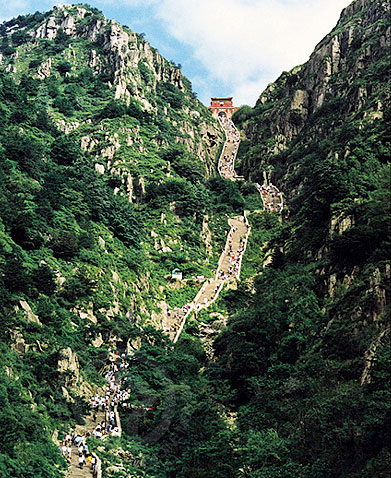Taishan Mountain Scenic Area
 Long ago Taishan Mountain was called Mt. Daishan or Mt. Daizong. It was renamed Taishan Mountain during the Spring and Autumn Period. Since 1987 it has been listed as a world cultural heritage site.
Long ago Taishan Mountain was called Mt. Daishan or Mt. Daizong. It was renamed Taishan Mountain during the Spring and Autumn Period. Since 1987 it has been listed as a world cultural heritage site.
Taishan Mountain is in central Shandong Province and is 426 square kilometers in area; its circumference is 80 kilometers. The main peak, Jade Emperor peak, rises 1,545 meters above sea level and is north of Tai′an city. The mountain is an early birthplace of China′s ancient civilization and the area around was one of ancient China′s political, economic and cultural centers. Seventy two emperors from Xia, Shang and Zhou dynasties built temples on it. After Qin Shihuang (246-209 B.C.), emperors and scholars from various historical periods went to Taishan Mountain and this accounts for the large quantity of precious cultural relics.
Taishan Mountain has 72 majestic peaks, magnificent waterfalls, centuries-old pines and cypresses and fascinating rocks. There are five tour1ist zones and two routes up the mountain-one in the east and one in the west. They meet at Zhongtian Gate and there are 6,293 steps in the nine kilometers leading to the top. Scenic spots include Longtan Reservoir, Zhongtian Gate, Five Doctor Pine, Duansong Hill, 18 Turns, South Gate to Heaven, Bixia Temple, Zhanglu Terrace, Sun-Watching Peak, Moon-Watching Peak. The four wonders of the mountain are Sun Rises from the East, Golden Belt Along the Yellow River, Beautiful Sunset and the Sea of Clouds. Other attractive spots are the Rare Rock Dock, Fan Cliff, Aolai Peak, Black Dragon Pool, Longevity Bridge, and the Dragon Pool Waterfall.
Running from Songshan Valley to the South Gate to Heaven, on the top of Danshan Hill, is a path with 18 turns called Ladder to Heaven. Although the path is little more than one kilometer long it rises 400 meters. The steps along the path are made of Tianshan schist. There is now a cable car from Zhongtian Gate to the top of Wangfu Hill.
Taishan Mountain is one of China′s mountain parks and is a natural museum of history and art. Along its axis there are 1,800 stone sculptures including famous ones such as the Cared Road from the Qin Dynasty, the Buddhist Diamond Sutra in Sutra Stone Valley, the Wordless Stone Tablet and the Scripture of Taishan Mountain History carved on Tangmo Cliff. Tiankuang Hall in the Daimiao Temple, which is also on Taishan Mountain is one of the three great halls of China (the other two are the Hall of Supreme Harmony in the Forbidden City, Beijing, and Dacheng Hall in Qufu). The 40 statues of arhat in the Thousand-Buddha Hall of the Lingyan Temple date back to the Song Dynasty and are prized for their individuality and expressiveness.
Included in the UNESCO world heritage list in 1987.
Source: http://old.cnta.gov.cn